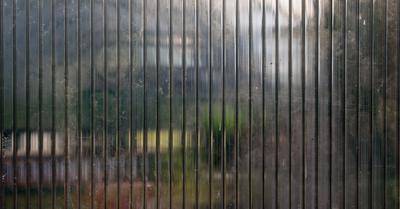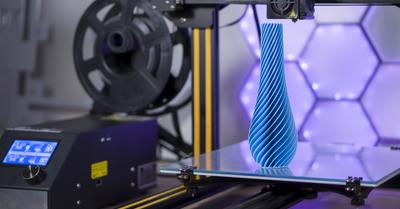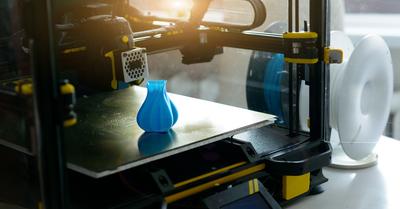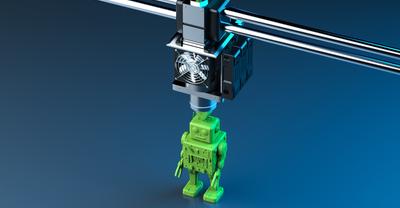The Direct Calculation Method
Perhaps the easiest and most straightforward method of calculating how many pieces you can expect to print from a 1Kg spool of filament is the direct method. The direct method doesn’t require much math.
The direct method requires that you print one example of your project piece and then weigh the example. You can easily calculate the number of pieces you should expect to get from a 1Kg spool of filament based on the finished piece’s weight.
Let the Software do the Work.
If you create your 3D models and use a slicing program to prepare the rendering for the printer, you may already have an estimate of the amount of filament needed for your project. Most slicing programs will give you an estimate of either the weight of the finished project or the length of filament needed to create the project.
Knowing how much filament you need, either by weight or length, allows you to estimate if you have enough filament on a used spool to complete the project. There are ways to connect spools of filament for projects that require more than one spool.
Estimate the Volume and Do the Math
If you create solid projects, you may estimate the piece’s volume and use that estimation to calculate the volume of filament. More math can give you the length of the filament, based on its diameter, used to make the model.
This method doesn’t work well with 3D projects with many openings or voids or irregular in shape and size. Estimating the volume of the solid parts of such a model is almost impossible for most people.
What is “Slicer” Software
Most 3D objects intended for 3D printing are designed using specialized CAD (Computer Assisted Design) software that allows realistic 3D modeling. However, once the model design is complete, it is still not ready for your 3D printer.
A specialized software application called a slicer takes the 3D rending and breaks it into a series of slices of the model. These slices tell the 3D printer where to put material and where not to put material. The slicer file is what controls the printing.
Slicer software delivers a lot of information to the 3D printer during the printing process. The slicer file tells the 3D printer
- What path to follow during the printing process
- What speed to use during printing
- How thick to lay down the material?
- The required tolerances for the finished project
Are There Ways to Use Less Filament?
There are many ways you can make your 3D printing more filament efficient.
- Reduce the size of your model
- Make hollow models whenever possible
- Reduce or eliminate support structures
- Save your waste filament and reuse it
Model Size – Bigger Means More
Look at your model size. For example, let’s look at a cube that is 10mm in each dimension. The volume of the cube is 1000 mm3. If we reduce the cube to 8 mm on each dimension, the cube volume is now 512 mm3. A 2mm reduction in each dimension results in a savings of 488 mm3 of material. The savings in material is about 49%.
Do You Need a Solid Model?
Consider our cube from the previous example. If we can do without a solid model, we might produce a hollow model. If we make each of the model 1 mm thick walls, we can remove a block of material from the model that is 6 mm on each side.
The block of material saved by making the model hollow is 216 mm3. We have now reduced the total volume of filament needed to produce this model to 296 mm3. When compared to the original 10 mm cube, this represents a savings of almost 70%.
Support Structures Equal Waste
Complicated models often require support structures during the printing process. The removal of support structures after printing is complete generates waste. There are several strategies for eliminating or reducing support structures.
- Eliminate overhang angles – Overhang angles of greater than 45 degrees often require support structures during the printing process. Most slicer programs use algorithms to decide when and where to add support structures to a model. Reducing or eliminating angels of greater than 45 degrees can reduce the number of support structures during printing.
- Split the model – There may be instances where creating your model in two or more pieces is more economical than a single structure. Splitting your model into two or more parts will often eliminate the need for supporting structures.
- Modify the slice file – This is an option for the most advanced users. Slicer programs tend to be conservative in their estimation of the requirements for a model. Conservative designs ensure that the print is successful and ignores the economy of filament. Very experienced users may elect to modify the slice file and eliminate some support structures. However, this is dangerous and may cause the print to fail miserably.
Save that Waste Material – Become a Recycler
Some heavy users of their 3D printer, especially those that print complicated models with lots of support structures, invest in small filament extrusion machines. The waste filament is recyclable.
You can purchase small home-sized filament recycling machines or download the instructions and files to print and build a filament recycler. Heavy users of filament can generate considerable savings over time.
Choosing the Type of 3D Printer can Save Filament
3D printers come in several styles and types. The three most popular are
- FDM filament printers
- SLA resin printers
- SLS powder printers
Filament spools for FDM filament printers are considerably cheaper than wither SLA resins or SLS powders. The difference can make your models significantly cheaper to produce.
FMD printers also reduce filament usage on solid models by creating internal infill areas that use only 25 percent material rather than a solid infill like SLA or SLS printers.
For most home and hobby 3D print enthusiasts, an FDM filament printer is a much better choice and more economical to operate in the long run.
The Simple Answer vs. the Real World Answer
The obvious answer to the question, how much can you print with 1Kg for filament, is you can print 1Kg of models. What most people want to know is how many models will a 1Kg spool for filament create. That is a more complex answer and depends on several factors
- How big is the model?
- How complex is the model?
- Is the model solid?
- How many support structures are required?
We hope that this article has given you some insight into how much you can print with 1Kg of filament. On the surface, the answer seems simple. However, the complexities of 3D modeling and printing make the underlying answer more complicated.









